The Effect of High-Velocity Air-Fuel WC-12Co Coatings on the Wear and Corrosion Resistance of TC18 Titanium Alloy
Abstract
1. Introduction
2. Establishment of Numerical Model for HVAF
2.1. Calculation Area and Boundary Conditions
2.2. Gridding
2.3. Gas Dynamic Model
2.4. Turbulence Model of Spray Flame Flow
2.5. Combustion Reaction Model of Thermal Spraying
2.6. Discrete Phase Model of Particles
2.7. Analysis of Calculation Results
3. Optimization Design of Spraying Process Parameters Based on RSM
4. Experimental Characterization of HVAF
4.1. Experimental Materials
4.2. Experimental Method
5. Experimental Results and Analysis
5.1. Microstructure Analysis of Powder and Coatings
5.2. Micro-Hardness Detection
5.3. Wear Performance Research
5.4. Artificial Seawater Soaking Corrosion Experiment
5.5. Neutral Salt Spray Corrosion Experiment
6. Conclusions
- (1)
- The numerical calculations show that the temperature and pressure in the combustion chamber reach 2252 K and 497 kPa, respectively. The gas phase velocity reaches a peak value of 1482 m/s at the first Mach cone. There is a small amount of oxygen in the convergent section of the nozzle, which indicates that the propane fully burns near the central axis and the mixing ratio of air and propane is optimal. The maximum temperature and velocity of particles are 1572 K and 417 m/s, respectively.
- (2)
- Based on the response surface equation of Pt and Pv, the optimal parameter combination was obtained as follows: a reactant mass flow rate of 0.051 kg/s, an oxygen/fuel ratio of 2.83 and a nitrogen mass flow rate of 0.000325 kg/s.
- (3)
- The coating experiment showed that the coating prepared by the optimized process has great performance. The distribution of C, Co and W in the WC-12Co powder was uniform. The particles impacted the substrate with flatting deformation, which was in a shape of “cauliflower”. The sprayed particles and the substrate surface overlapped each other to form an “interlock”. The coating density is high and the microhardness was 2.8 times that of the substrate. The mean hardness of the TC18 substrate was 401.2 HV0.3 and the mean hardness of the WC-12Co coating was 1121 HV0.3. The friction coefficient between the TC18 substrate and the Si3N4 ceramic ball was 0.55, and the friction coefficient between the WC-12Co coating and the Si3N4 ceramic ball was 0.4. Compared with the TC18 substrate, the WC-12Co coating has excellent wear resistance and corrosion resistance. Its corrosion mechanism is as follows: the bonding phase Co with a high self-corrosion potential is preferentially corroded, forming corrosion pits and small cracks.
Author Contributions
Funding
Institutional Review Board Statement
Informed Consent Statement
Data Availability Statement
Conflicts of Interest
References
- Dong, S.; Wang, W.; Gao, Y.; Deng, G. Tribological Properties of Different-Sized Black Phosphorus Nanosheets as Water-Based Lubrication Additives for Steel/Titanium Alloy Wear Contact. Metals 2022, 12, 288. [Google Scholar] [CrossRef]
- Gao, Z.; Wang, L.; Wang, Y.; Lyu, F.; Zhan, X. Crack defects and formation mechanism of FeCoCrNi high entropy alloy coating on TC4 titanium alloy prepared by laser cladding. J. Alloys Compd. 2022, 903, 163905. [Google Scholar] [CrossRef]
- Kohli, K.; Bhattacharya, S.K.; Ueda, K.; Narushima, T.; Sahara, R.; Ghosh, P. Electronegativity Difference as a Descriptor for the Oxidation-Inhibiting Effect of the Alloying Element during the Early Stages of Titanium Oxidation. Langmuir 2022, 38, 1448–1457. [Google Scholar] [CrossRef] [PubMed]
- Luo, X.; Chidambaram-Seshadri, R.; Yang, G.-J. Micro-Nanostructured Cermet Coatings. In Advanced Nanomaterials and Coatings by Thermal Spray; Elsevier: Amsterdam, The Netherlands, 2019; pp. 61–117. [Google Scholar]
- Babu, P.S.; Madhavi, Y.; Krishna, L.R.; Sivakumar, G.; Rao, D.S.; Padmanabham, G. Thermal Spray Coatings for Erosion–Corrosion Resistant Applications. Trans. Indian. Inst. Met. 2020, 73, 2141–2159. [Google Scholar] [CrossRef]
- Koivuluoto, H. A Review of Thermally Sprayed Polymer Coatings. J. Therm. Spray Technol. 2022, 31, 1750–1764. [Google Scholar] [CrossRef]
- Sahraoui, T.; Fenineche, N.-E.; Montavon, G.; Coddet, C. Alternative to chromium: Characteristics and wear behavior of HVOF coatings for gas turbine shafts repair (heavy-duty). J. Mater. Process. Technol. 2004, 152, 43–55. [Google Scholar] [CrossRef]
- Li, M.; Christofides, P.D. Multi-scale modeling and analysis of an industrial HVOF thermal spray process. Chem. Eng. Sci. 2005, 60, 3649–3669. [Google Scholar] [CrossRef]
- Kumar, S.; Handa, A.; Chawla, V.; Grover, N.K.; Kumar, R. Performance of thermal-sprayed coatings to combat hot corrosion of coal-fired boiler tube and effect of process parameters and post-coating heat treatment on coating performance: A review. Surf. Eng. 2021, 37, 833–860. [Google Scholar] [CrossRef]
- Shamim, T.; Xia, C.; Mohanty, P. Modeling and analysis of combustion assisted thermal spray processes. Int. J. Therm. Sci. 2007, 46, 755–767. [Google Scholar] [CrossRef]
- Abbas, M.; Smith, G.M.; Munroe, P.R. Microstructural investigation of bonding and melting-induced rebound of HVOF sprayed Ni particles on an aluminum substrate. Surf. Coatings Technol. 2020, 402, 126353. [Google Scholar] [CrossRef]
- Jafari, H.; Emami, S.; Mahmoudi, Y. Numerical investigation of dual-stage high velocity oxy-fuel (HVOF) thermal spray process: A study on nozzle geometrical parameters. Appl. Therm. Eng. 2017, 111, 745–758. [Google Scholar] [CrossRef]
- Baik, J.S.; Kim, Y.J. Effect of nozzle shape on the performance of high velocity oxygen-fuel thermal spray system. Surf. Coat. Technol. 2008, 202, 5457–5462. [Google Scholar] [CrossRef]
- Kuroda, S.; Watanabe, M.; Kim, K.; Katanoda, H. Current Status and Future Prospects of Warm Spray Technology. J. Therm. Spray Technol. 2011, 20, 653–676. [Google Scholar] [CrossRef]
- Liu, S.L.; Zheng, X.P.; Geng, G.Q. Influence of nano-WC–12Co powder addition in WC–10Co–4Cr AC-HVAF sprayed coatings on wear and erosion behaviour. Wear 2010, 269, 362–367. [Google Scholar] [CrossRef]
- Valarezo, A.; Choi, W.B.; Chi, W.; Gouldstone, A.; Sampath, S. Process Control and Characterization of NiCr Coatings by HVOF-DJ2700 System: A Process Map Approach. J. Therm. Spray Technol. 2010, 19, 852–865. [Google Scholar] [CrossRef]
- Nourouzi, S.; Azizpour, M.J.; Salimijazi, H.R. Parametric Study of Residual Stresses in HVOF Thermally Sprayed WC–12Co Coatings. Mater. Manuf. Process. 2014, 29, 1117–1125. [Google Scholar] [CrossRef]
- Myalska, H.; Szymański, K.; Moskal, G. Microstructure and Properties Of WC-Co HVAF Coatings Obtained from Standard, Superfine and Modified by Sub-Micrometric Carbide Powders. Arch. Met. Mater. 2015, 60, 759–766. [Google Scholar] [CrossRef]
- Vijay, S.; Wang, L.; Lyphout, C.; Nylen, P.; Markocsan, N. Surface characteristics investigation of HVAF sprayed cermet coatings. Appl. Surf. Sci. 2019, 493, 956–962. [Google Scholar] [CrossRef]
- Ahmed, R.; Ali, O.; Berndt, C.C.; Fardan, A. Sliding Wear of Conventional and Suspension Sprayed Nanocomposite WC-Co Coatings: An Invited Review. J. Therm. Spray Technol. 2021, 30, 800–861. [Google Scholar] [CrossRef]
- Li, C.; Gao, X.; Yang, Y.; Chen, X.; Han, X. Sensitivity Analysis of Process Parameters of Warm Spraying Process Based on Response Surface Method. J. Therm. Spray Technol. 2022, 31, 585–597. [Google Scholar] [CrossRef]
- Zhou, Z.; Chen, Y.; Hu, Z.; Shen, B.; Liang, X. Numerical Investigation of Particles in Warm-Particle Peening-Assisted High-Velocity Oxygen Fuel (WPPA-HVOF) Spraying. J. Therm. Spray Technol. 2020, 29, 1682–1694. [Google Scholar] [CrossRef]
- Khan, M.N.; Shamim, T.J.A.E. Investigation of a dual-stage high velocity oxygen fuel thermal spray system. Appl. Energy 2014, 130, 853–862. [Google Scholar] [CrossRef]
- Magnussen, B.F.; Hjertager, B.H. On mathematical modeling of turbulent combustion with special emphasis on soot formation and combustion. Symp. Int. Combust. 1977, 16, 719–729. [Google Scholar] [CrossRef]
- Yu, J.; Liu, X.; Yu, Y.; Li, H.; Liu, P.; Sun, R.; Wang, L.; Li, P. Numerical Analysis of High-Velocity Oxygen Fuel Thermal-Spray Process for Fe-Based Amorphous Coatings. Coatings 2021, 11, 1533. [Google Scholar] [CrossRef]
- Yu, J.; Liu, X.; Yu, Y.; Li, Z.; Xu, S.; Li, H.; Liu, P.; Wang, L. Effect of HVOF Spraying Process on Particle Behavior of Fe-Based Amorphous Alloy Coatings. J. Therm. Spray Technol. 2022, 31, 2448–2462. [Google Scholar] [CrossRef]
- Jones, W.P.; Lindstedt, R.P.J.C. Global reaction schemes for hydrocarbon combustion. Combust. Flame 1988, 73, 233–249. [Google Scholar] [CrossRef]
- Liu, F.; Li, Z.; Fang, M.; Hou, H. Numerical analysis of the activated combustion high-velocity air-fuel spraying process: A three-dimensional simulation with improved gas mixing and combustion mode. Materials 2021, 14, 657. [Google Scholar] [CrossRef]
- Gao, X.; Li, C.; Zhang, D.; Gao, H.; Han, X. Numerical analysis of the activated combustion high-velocity air-fuel (AC-HVAF) thermal spray process: A survey on the parameters of operation and nozzle geometry. Surf. Coatings Technol. 2020, 405, 126588. [Google Scholar] [CrossRef]
- Jiang, H.-R.; Li, M.-L.; Wei, X.-S.; Ma, T.-C.; Dong, Y.; Ying, C.-X.; Liao, Z.-Y.; Shen, J. Numerical Investigation of In-Flight Behavior of Fe-Based Amorphous Alloy Particles in AC-HVAF Thermal Spray Process. J. Therm. Spray Technol. 2019, 28, 1146–1159. [Google Scholar] [CrossRef]
- Hamzawy, N.; Mahmoud, T.S.; El-Mahallawi, I.; Khalifa, T.; Khedr, M. Optimization of Thermal Drilling Parameters of 6082 Al-Alloy Based on Response Surface Methodology. Arab. J. Sci. Eng. 2023. [Google Scholar] [CrossRef]
- Hui, S.; Tianyuan, S.; Dejun, K. Surface and cross-section characteristics and friction-wear properties of high velocity oxy fuel sprayed WC-12Co coating. Int. J. Appl. Ceram. Technol. 2018, 15, 1229–1239. [Google Scholar] [CrossRef]
- Mazouzi, A.; Djerdjare, B.; Triaa, S.; Rezzoug, A.; Cheniti, B.; Aouadi, S.M. Effect of annealing temperature on the microstructure evolution, mechanical and wear behavior of NiCr–WC–Co HVOF-sprayed coatings. J. Mater. Res. 2020, 35, 2798–2807. [Google Scholar] [CrossRef]
- Hu, K.; Liu, X.; Zhang, S.; Xue, Z.; Yang, Y.; Yang, K. Tribocorrosion behavior of HVOF sprayed WC-based cermet coatings in sodium chloride solution environment in relation to binder phases. Surf. Coat. Technol. 2022, 435, 128248. [Google Scholar] [CrossRef]
- Lv, Y.; Zhang, P.; Wei, D.; Chen, X.; Ding, F.; Su, F.; Li, H. Corrosion behavior of Al2O3-WER and WC-Co-WER coatings on TC18 in neutral salt spray environment. Mater. Res. Express 2018, 5, 066411. [Google Scholar] [CrossRef]

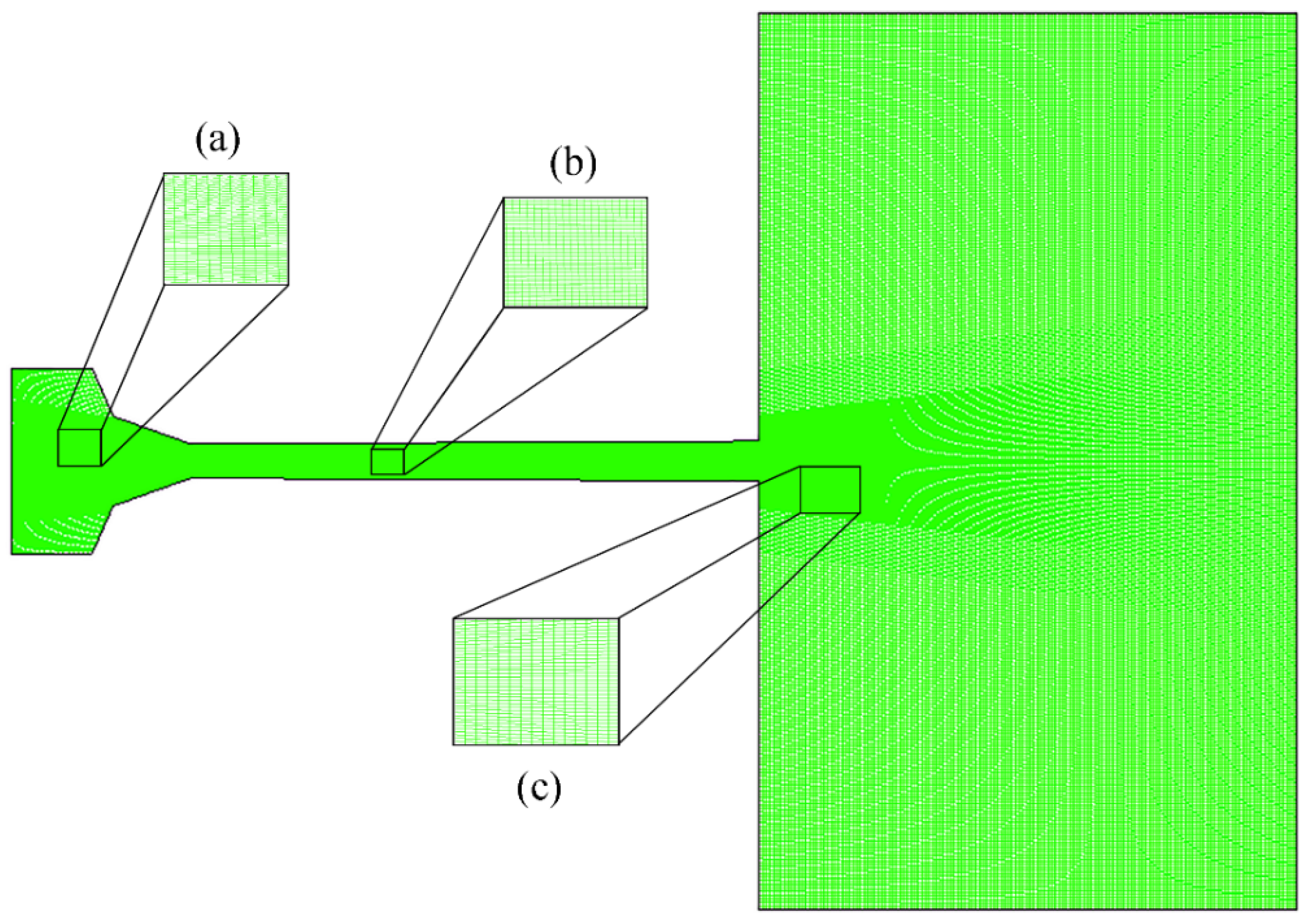



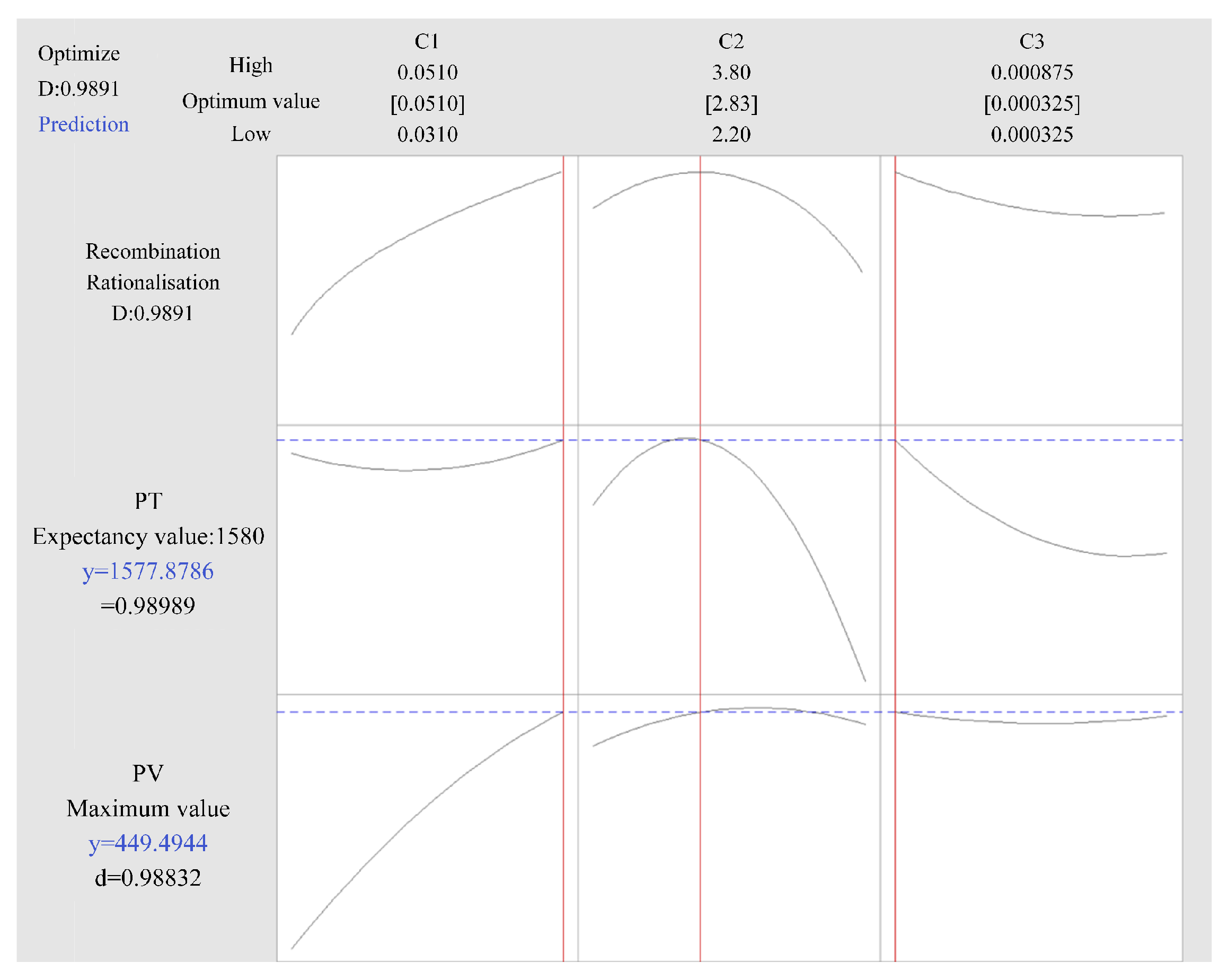
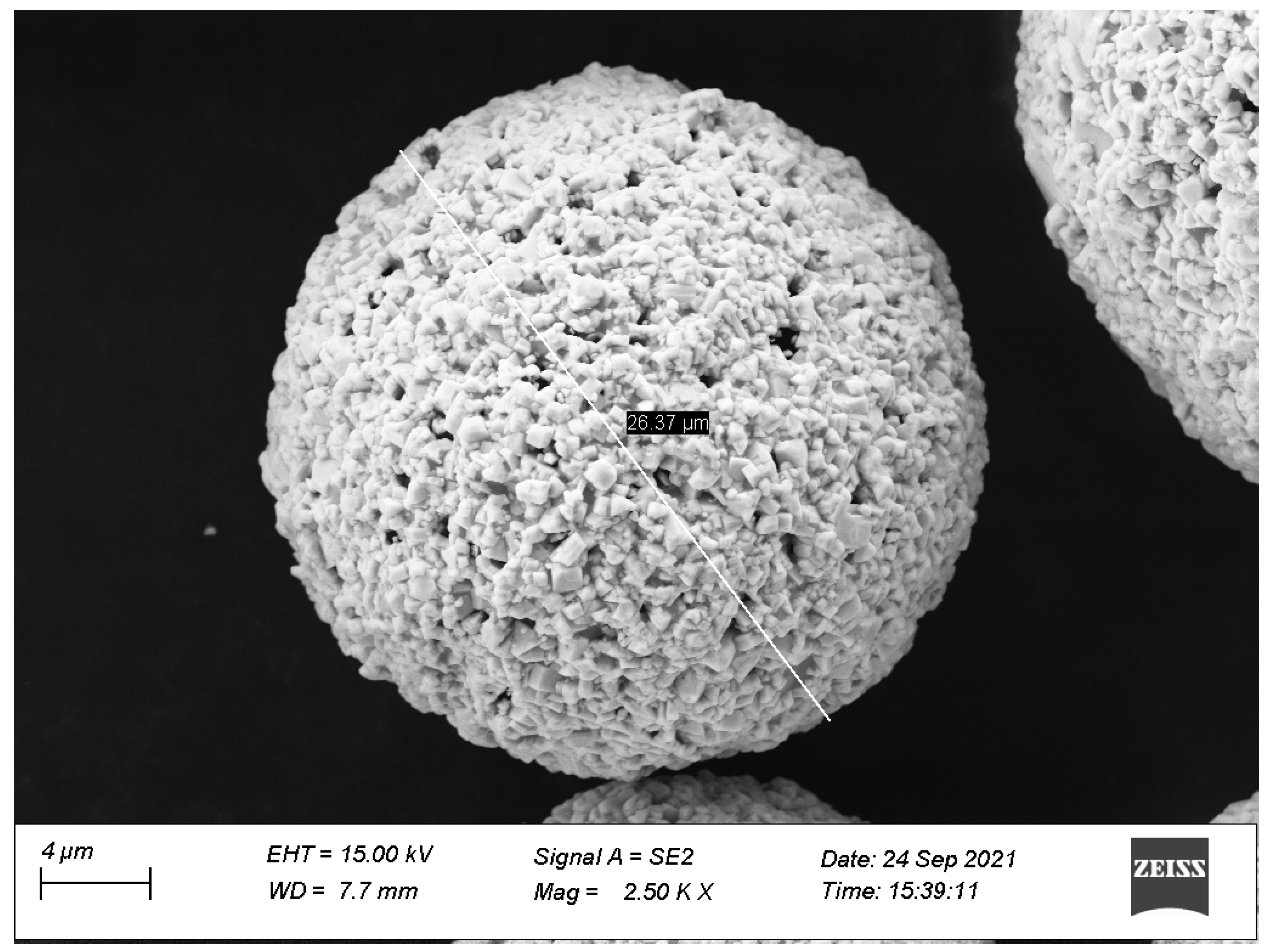


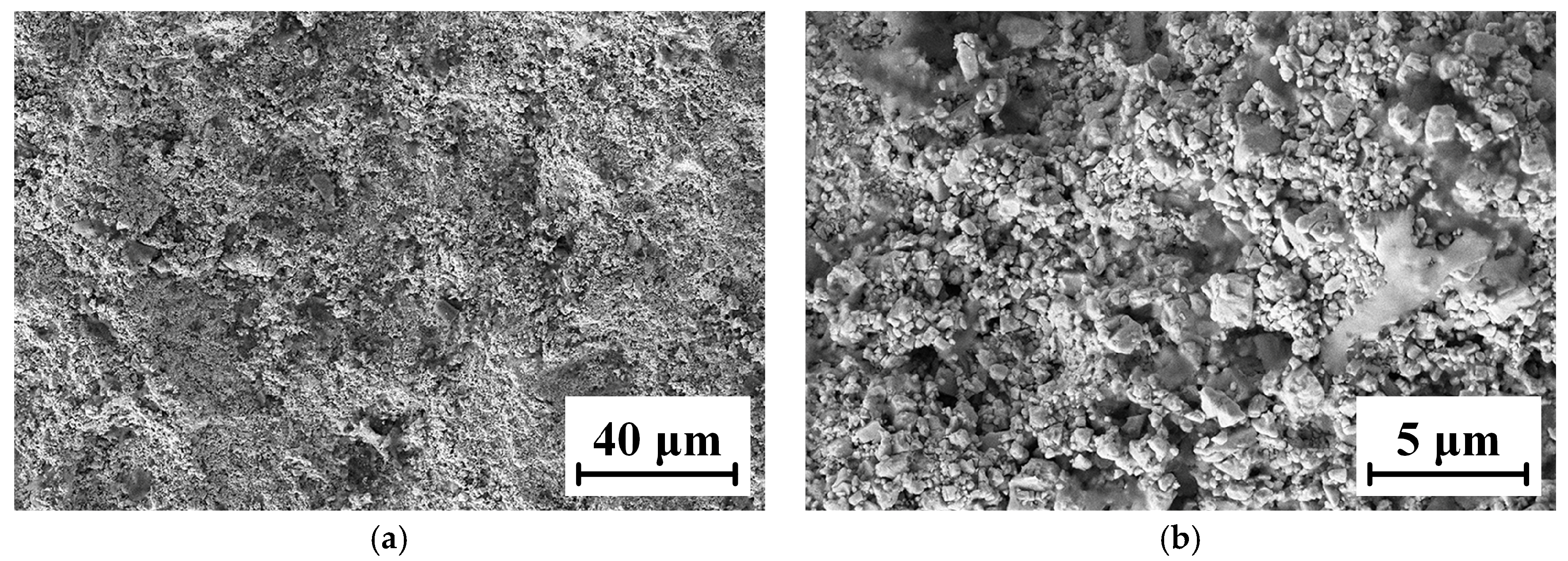
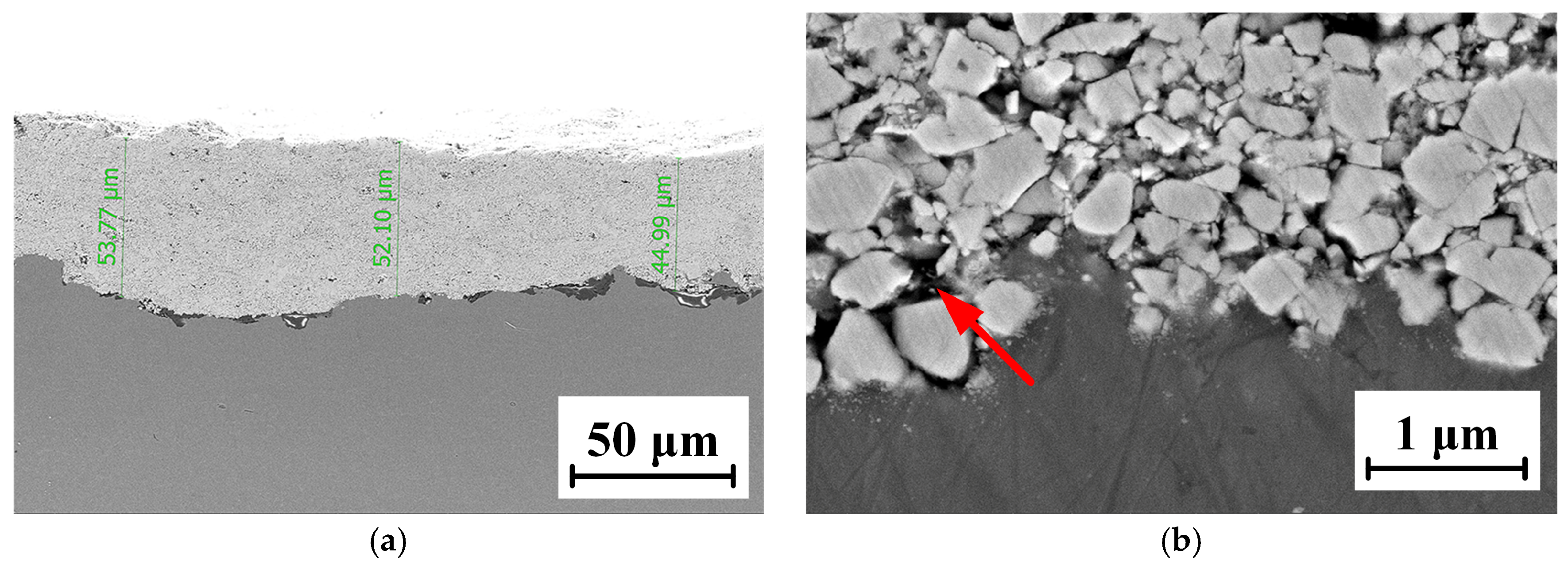
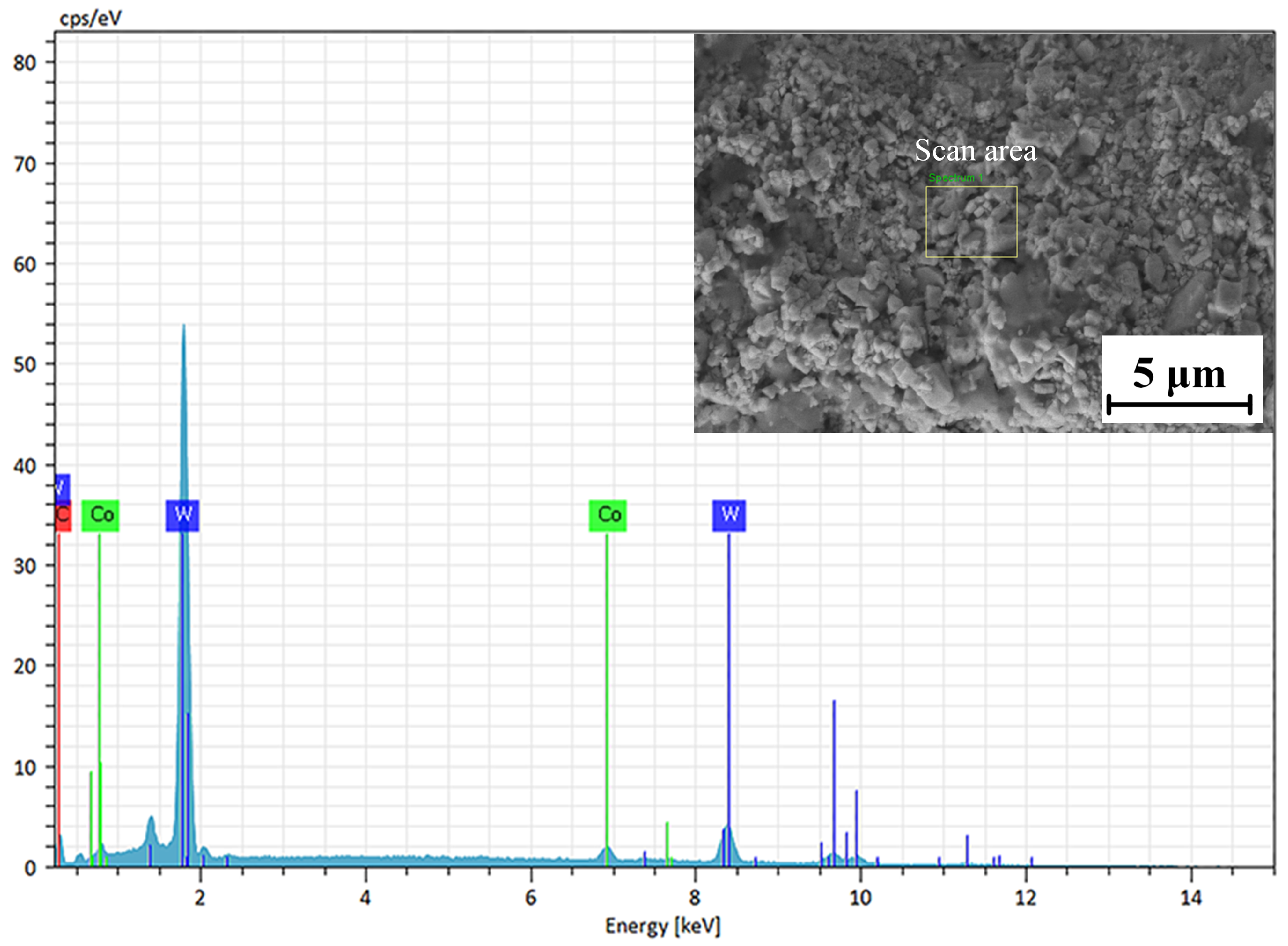
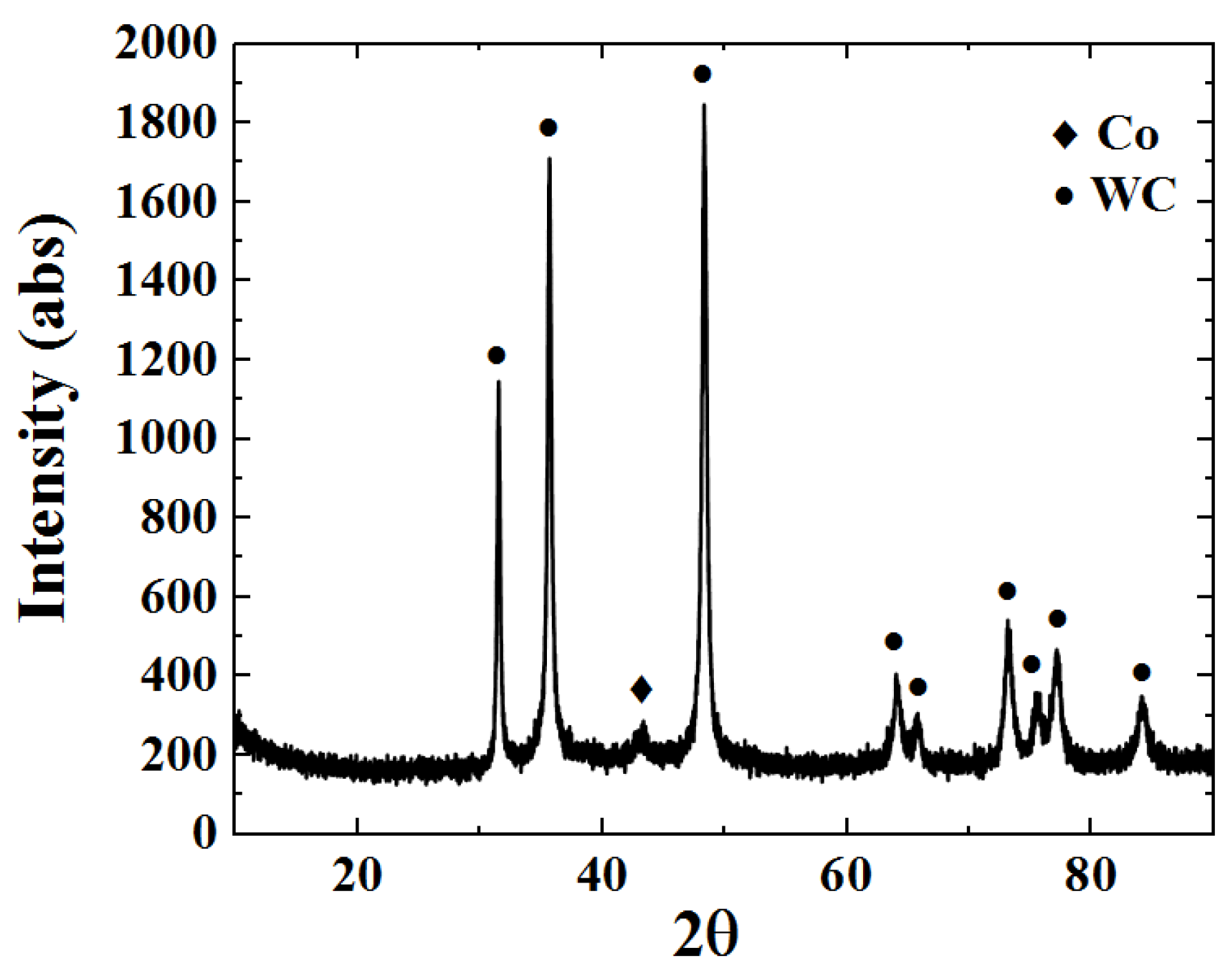


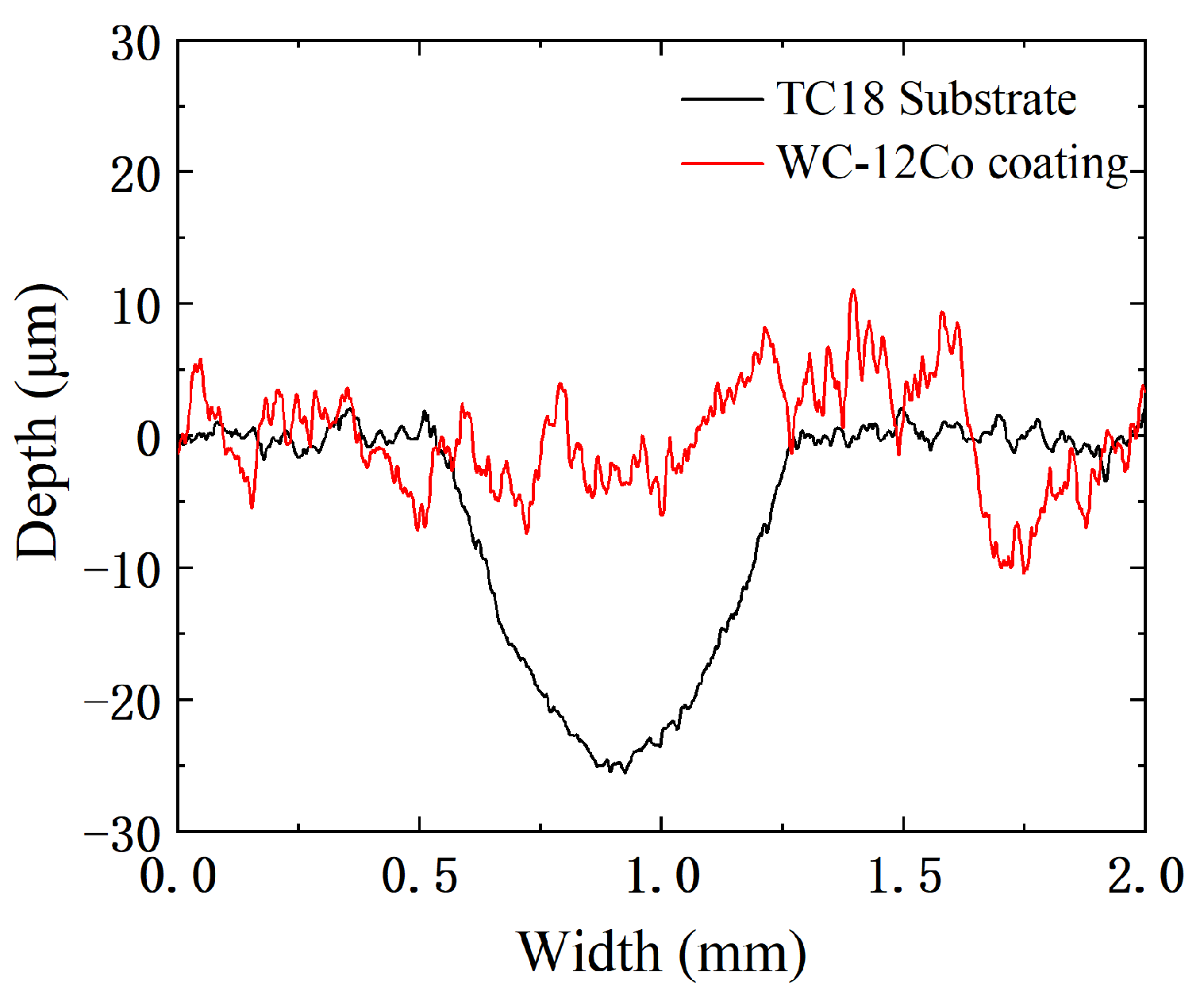
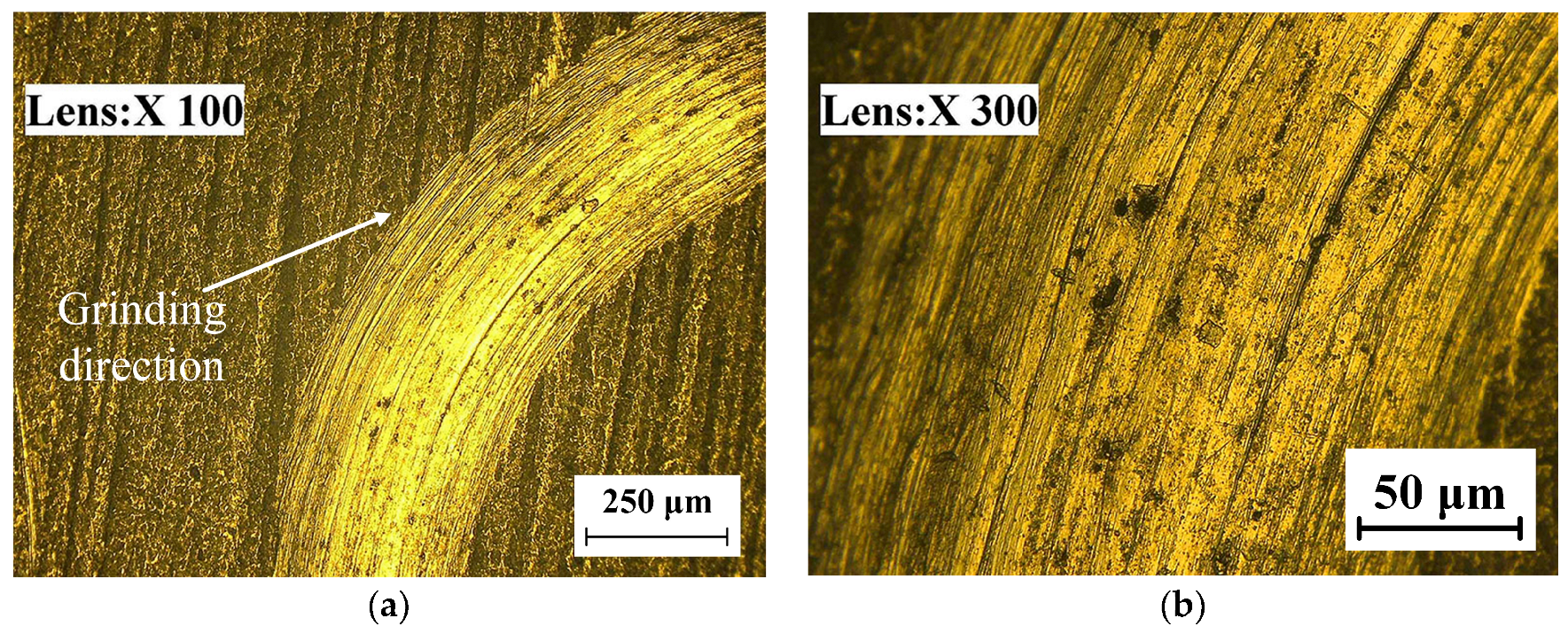
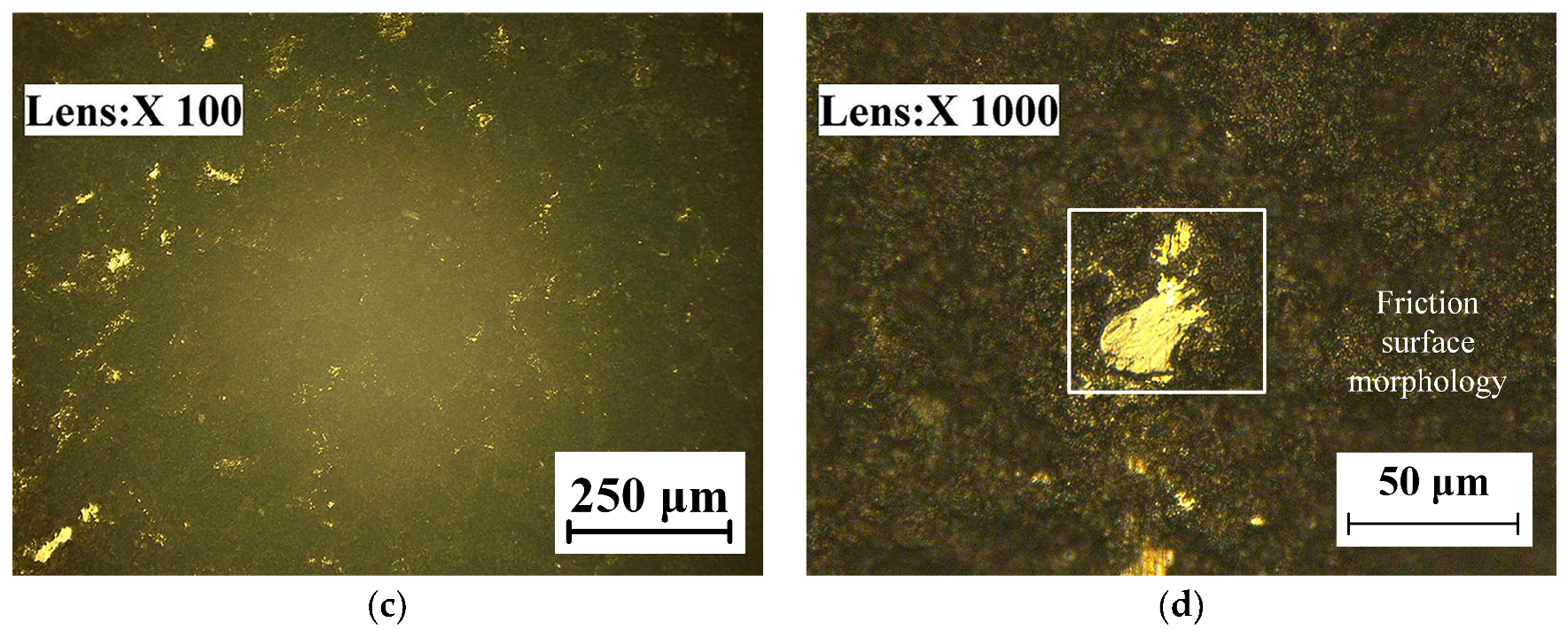
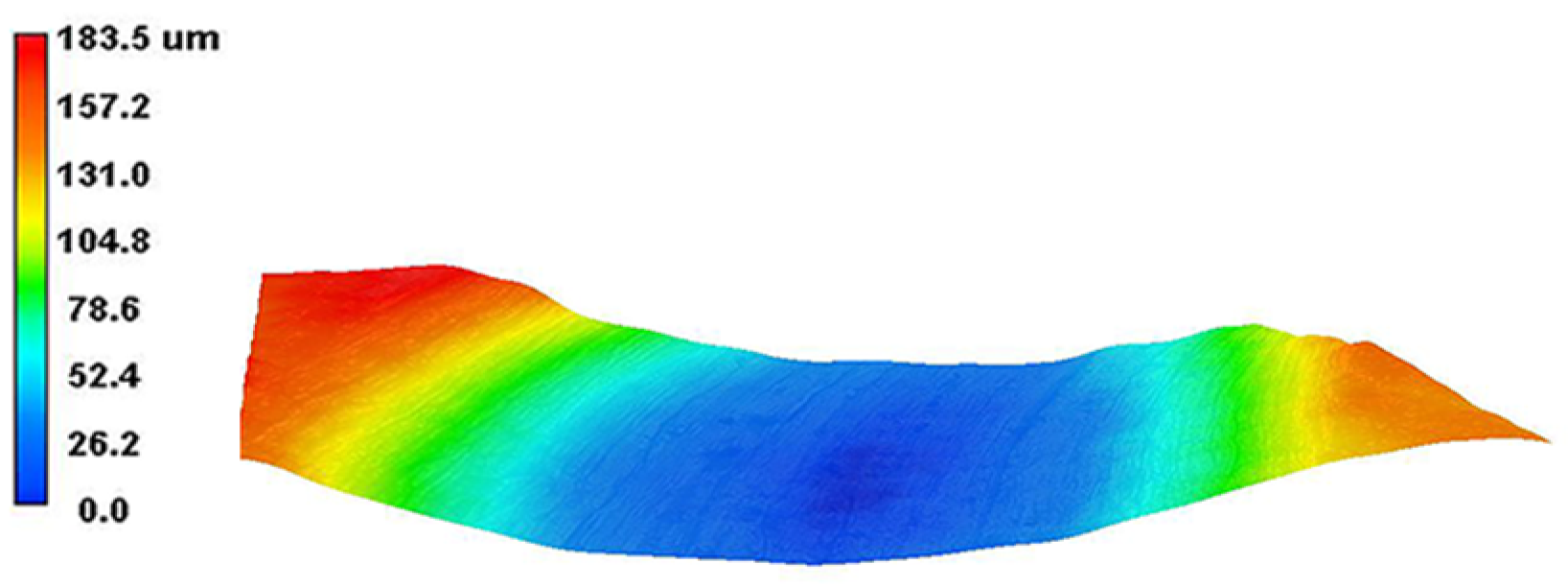
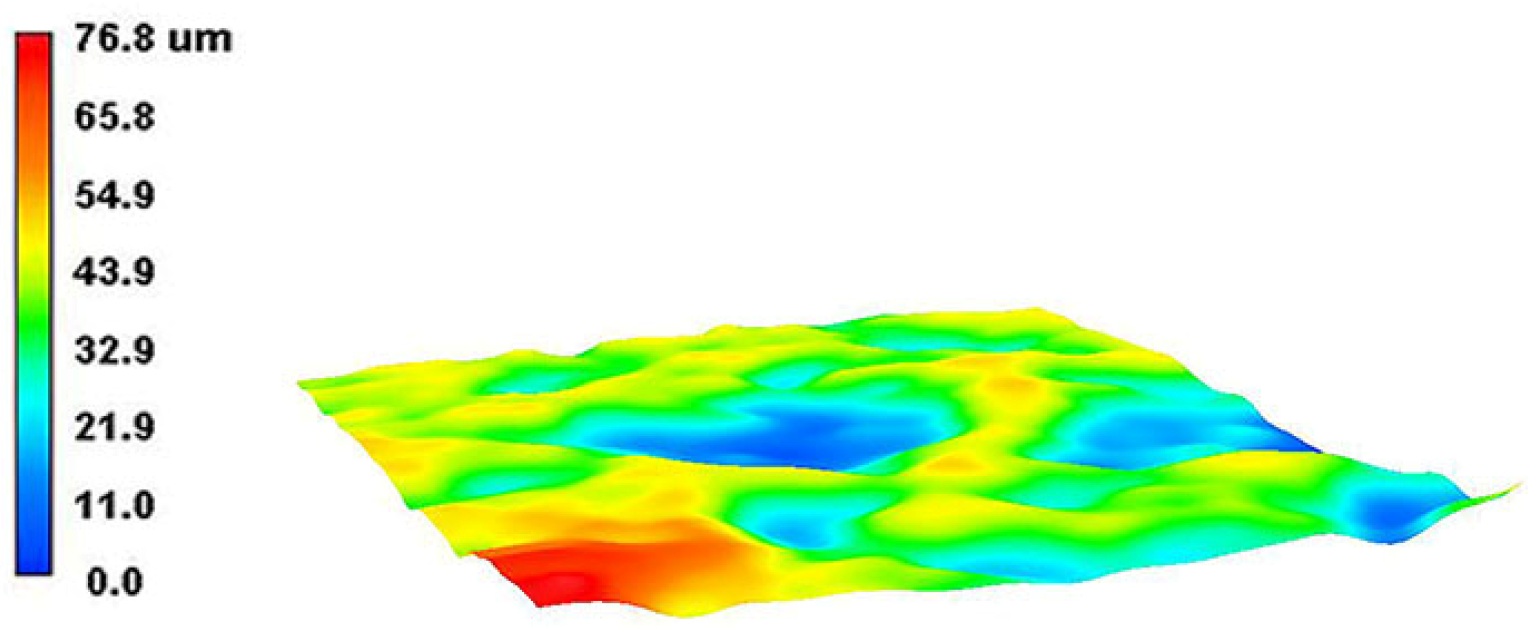
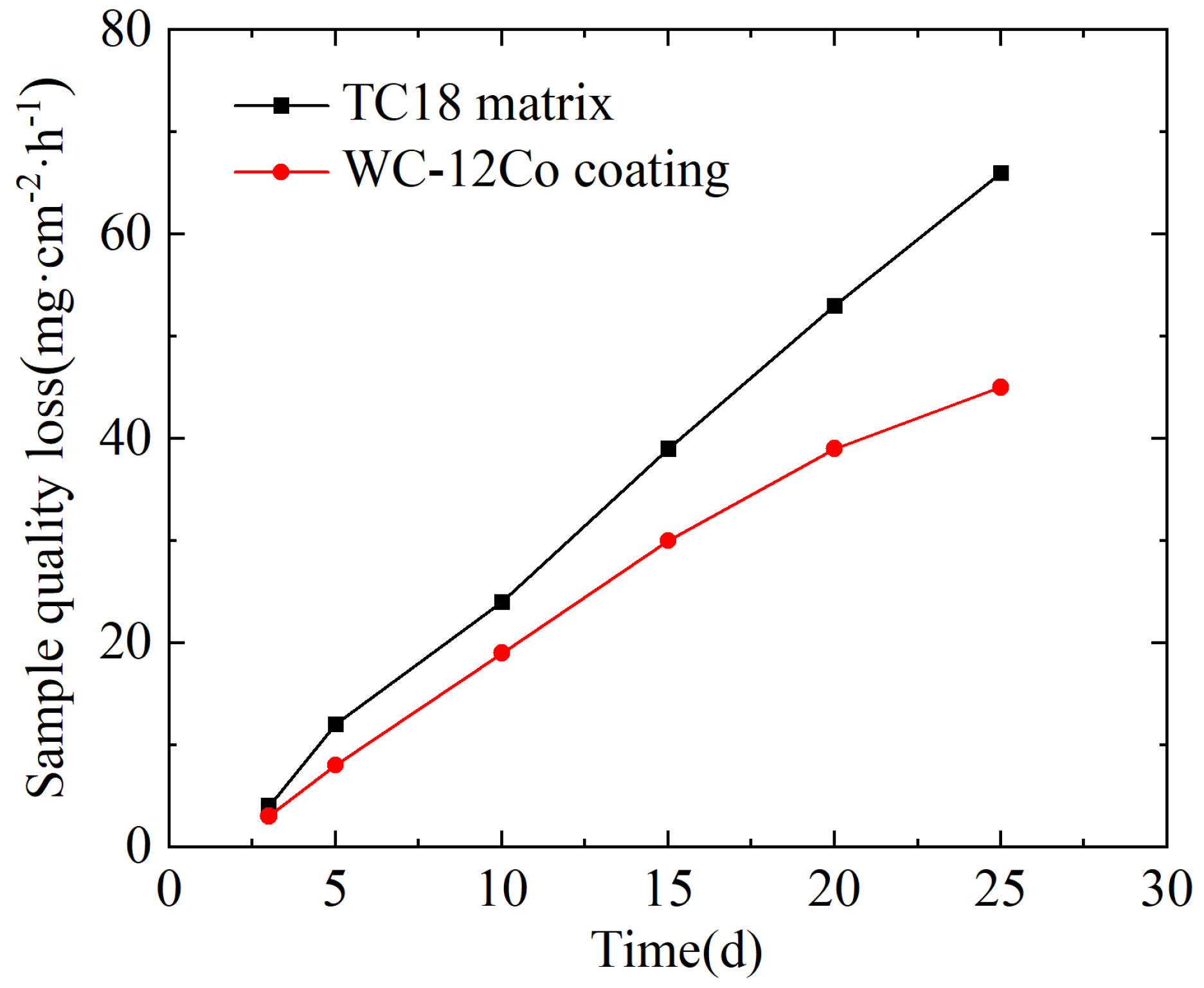
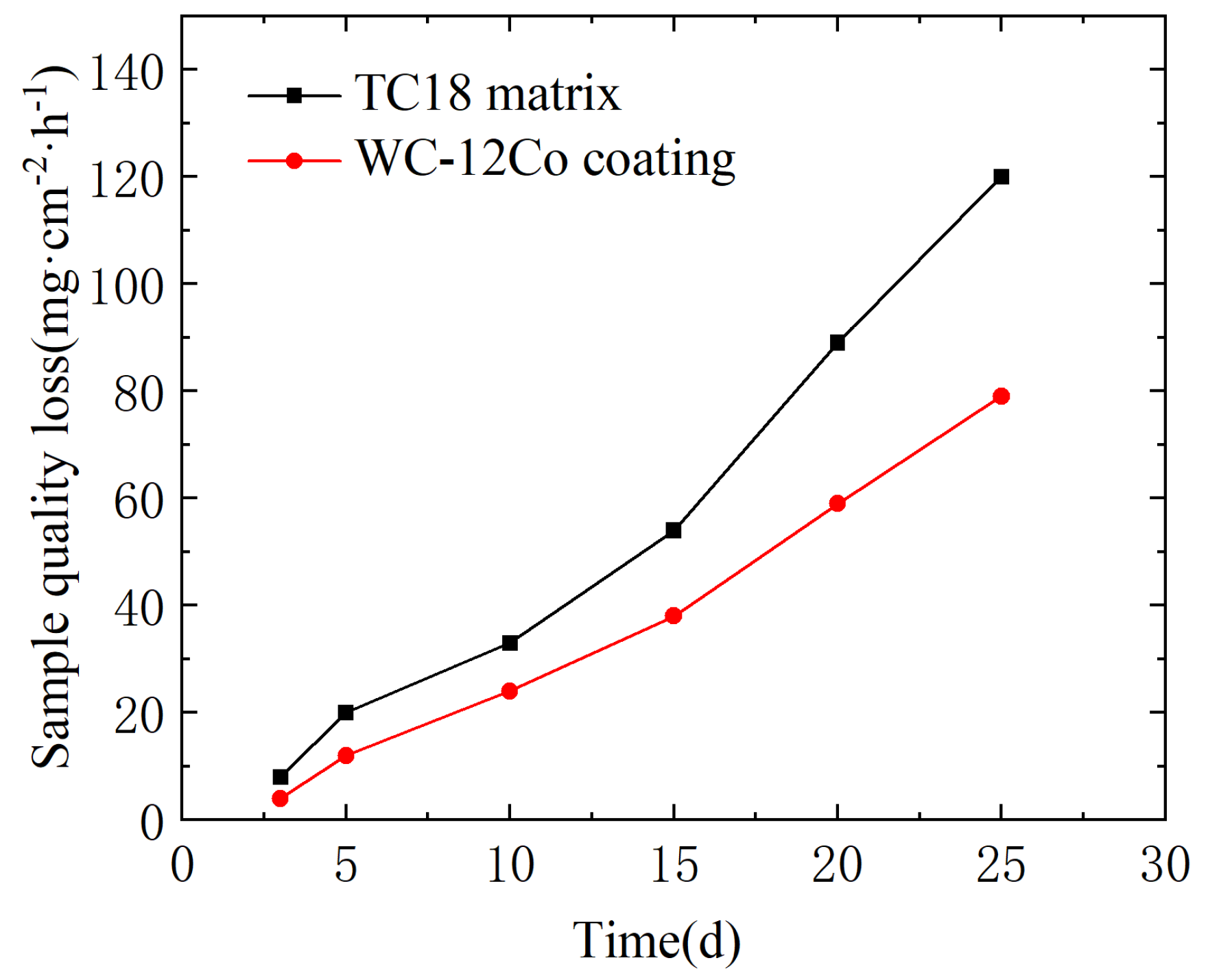

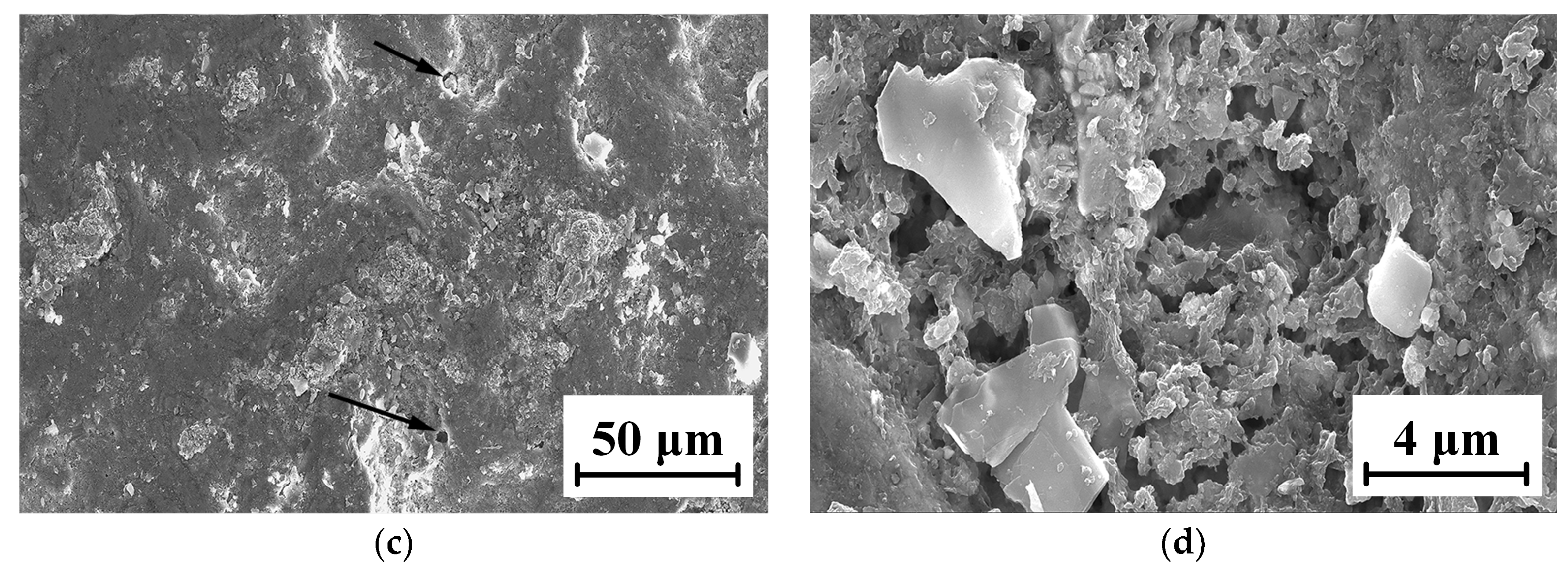
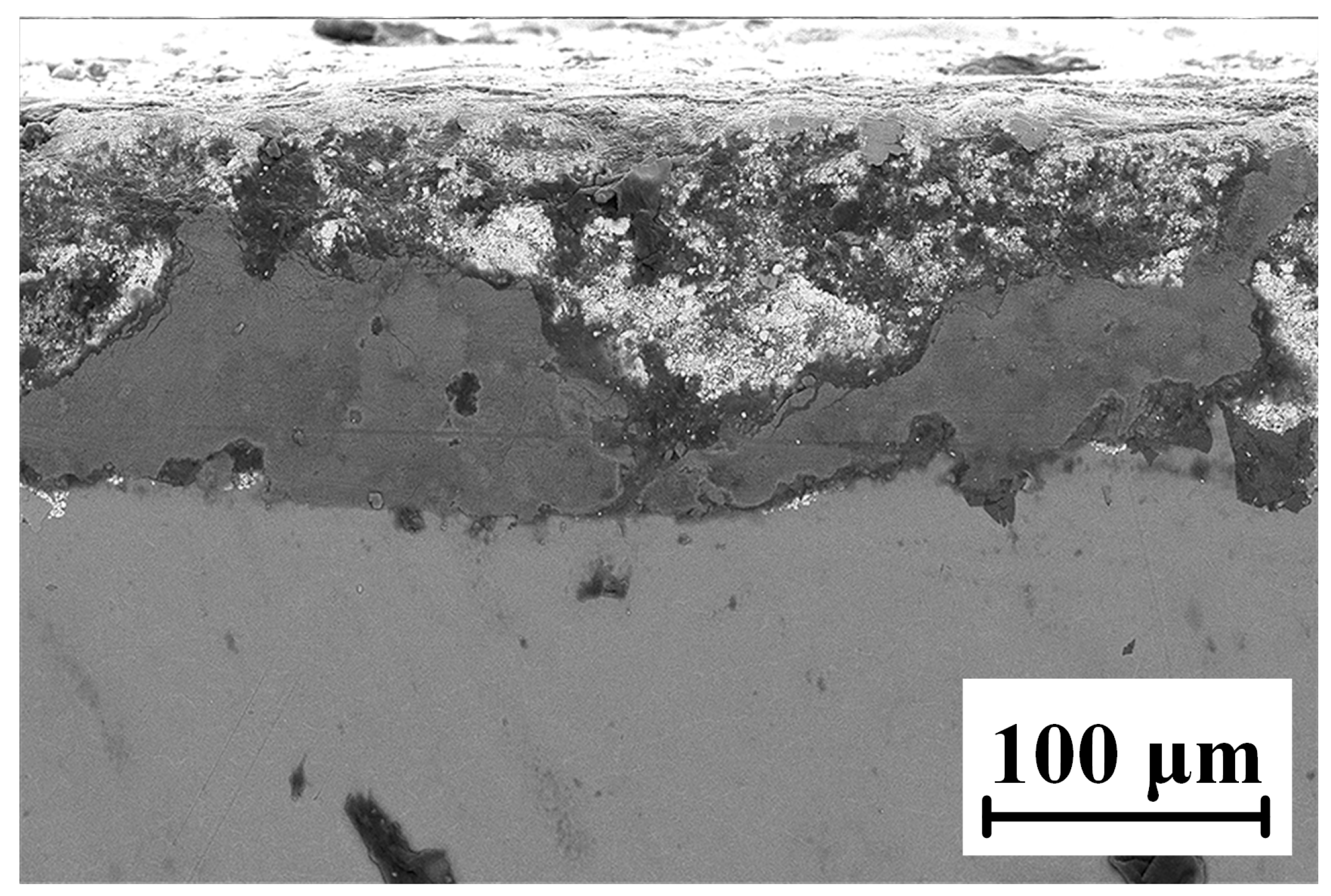
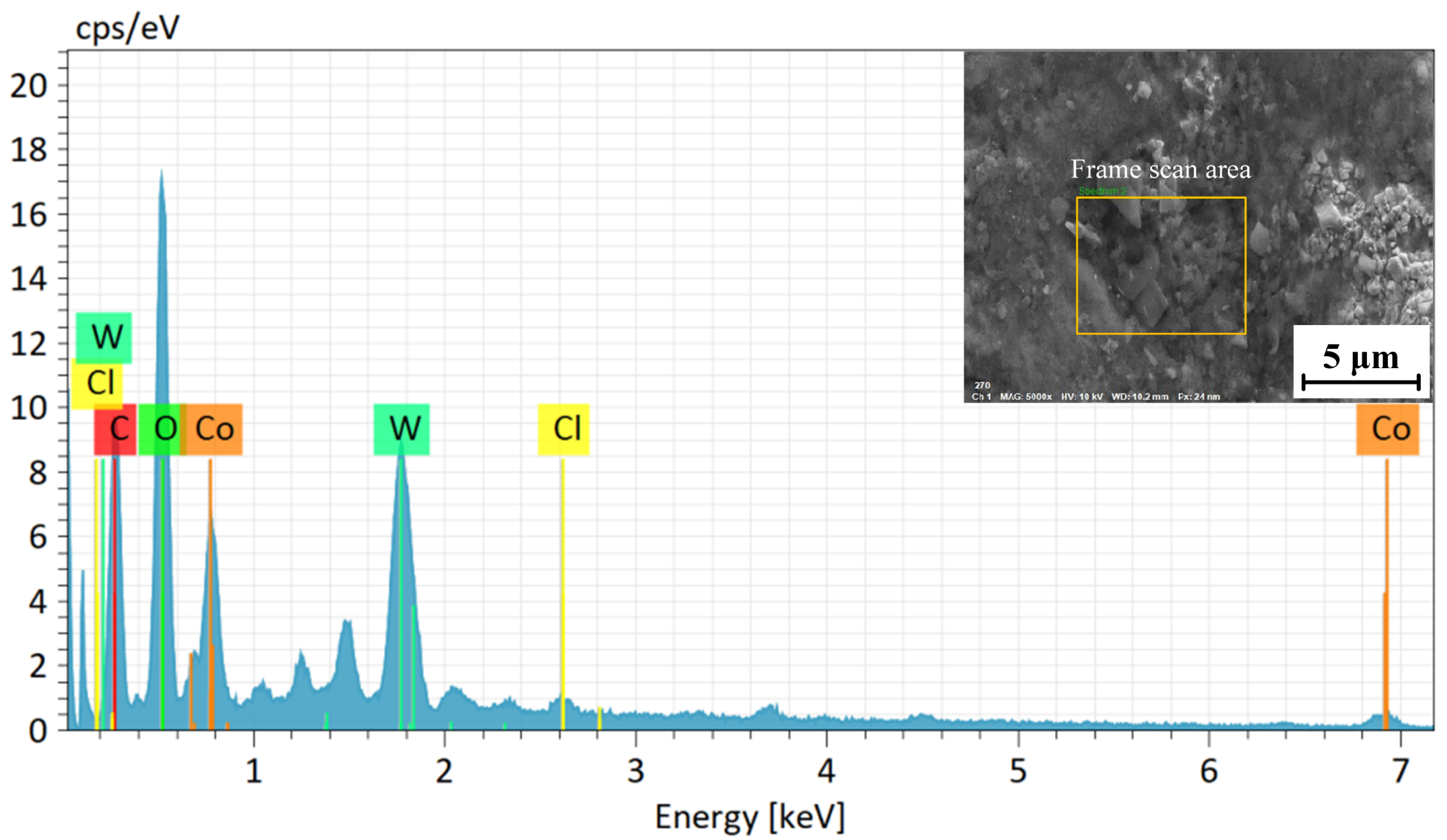
| Factor | Variable | Level | ||
|---|---|---|---|---|
| −1 | 0 | 1 | ||
| Total mass flow of reactant/kg/s | C1 | 0.031 | 0.041 | 0.051 |
| Oxygen/fuel mass ratio | C2 | 2.2 | 3.0 | 3.8 |
| Nitrogen mass flow/kg/s | C3 | 0.000325 | 0.0006 | 0.000875 |
| Order Number | C1/kg/s | C2 | C3/kg/s | Pv/m/s | Pt/K |
|---|---|---|---|---|---|
| 1 | 0.031 | 3.0 | 0.000875 | 385.616 | 1507.20 |
| 2 | 0.041 | 3.0 | 0.000600 | 421.840 | 1493.76 |
| 3 | 0.051 | 3.0 | 0.000875 | 448.287 | 1512.45 |
| 4 | 0.051 | 3.0 | 0.000325 | 450.409 | 1576.17 |
| 5 | 0.041 | 3.0 | 0.000600 | 421.649 | 1492.11 |
| 6 | 0.051 | 3.8 | 0.000600 | 444.082 | 1385.89 |
| 7 | 0.031 | 3.0 | 0.000325 | 381.658 | 1547.97 |
| 8 | 0.041 | 2.2 | 0.000875 | 417.374 | 1447.50 |
| 9 | 0.041 | 3.8 | 0.000325 | 415.080 | 1430.74 |
| 10 | 0.041 | 3.8 | 0.000875 | 417.750 | 1370.27 |
| 11 | 0.031 | 2.2 | 0.000600 | 372.070 | 1492.76 |
| 12 | 0.051 | 2.2 | 0.000600 | 436.141 | 1484.71 |
| 13 | 0.041 | 3.0 | 0.000600 | 420.208 | 1517.12 |
| 14 | 0.041 | 2.2 | 0.000325 | 414.369 | 1532.59 |
| 15 | 0.031 | 3.8 | 0.000600 | 372.160 | 1380.61 |
| Pv | Freedom | Seq SS | Distribution | Adj SS | Adj MS | F Value | p Value |
|---|---|---|---|---|---|---|---|
| Model | 8 | 9424.85 | 99.87% | 9424.85 | 1178.11 | 584.11 | 0.000 |
| Linear | 3 | 8956.29 | 94.91% | 8956.29 | 2985.43 | 1480.19 | 0.000 |
| C1 | 1 | 8938.85 | 94.72% | 8938.85 | 8938.85 | 4431.91 | 0.000 |
| C2 | 1 | 10.39 | 0.11% | 10.39 | 10.39 | 5.15 | 0.064 |
| C3 | 1 | 7.05 | 0.07% | 7.05 | 7.05 | 3.50 | 0.111 |
| Square | 3 | 443.91 | 4.70% | 443.91 | 147.97 | 73.36 | 0.000 |
| C1 × C1 | 1 | 184.05 | 1.95% | 201.37 | 201.37 | 99.84 | 0.000 |
| C2 × C2 | 1 | 234.02 | 2.48% | 220.86 | 220.86 | 109.51 | 0.000 |
| C3 × C3 | 1 | 25.83 | 0.27% | 25.83 | 25.83 | 12.81 | 0.012 |
| Interaction | 2 | 24.65 | 0.26% | 24.65 | 12.33 | 6.11 | 0.036 |
| C1 × C2 | 1 | 15.41 | 0.16% | 15.41 | 15.41 | 7.64 | 0.033 |
| C1 × C3 | 1 | 9.24 | 0.10% | 9.24 | 9.24 | 4.58 | 0.076 |
| Error | 6 | 12.10 | 0.13% | 12.10 | 2.02 | ||
| Lack of fit | 4 | 10.51 | 0.11% | 10.51 | 2.63 | 3.30 | 0.246 |
| Pure error | 2 | 1.59 | 0.02% | 1.59 | 0.80 | ||
| R2 = 99.87% | = 99.70% | = 98.68% | |||||
| Pt | Freedom | Seq SS | Distribution | Adj SS | Adj MS | F Value | p Value |
|---|---|---|---|---|---|---|---|
| Model | 6 | 53,310.8 | 97.76% | 53,310.8 | 8885.1 | 58.22 | 0.000 |
| Linear | 3 | 26,950.7 | 49.42% | 26,950.7 | 8983.6 | 58.87 | 0.000 |
| C1 | 1 | 117.7 | 0.22% | 117.7 | 117.7 | 0.77 | 0.406 |
| C2 | 1 | 19,017.4 | 34.87% | 19,017.4 | 19,017.4 | 124.61 | 0.000 |
| C3 | 1 | 7815.6 | 14.33% | 7815.6 | 7815.6 | 51.21 | 0.000 |
| Square | 3 | 26,360.2 | 48.34% | 26,360.2 | 8786.7 | 57.58 | 0.000 |
| C1 × C1 | 1 | 1055.5 | 1.94% | 608.2 | 608.2 | 3.99 | 0.081 |
| C2 × C2 | 1 | 23,498.6 | 43.09% | 22,371.0 | 22,371.0 | 146.59 | 0.000 |
| C3 × C3 | 1 | 1806.1 | 3.31% | 1806.1 | 1806.1 | 11.83 | 0.009 |
| Error | 8 | 1220.9 | 2.24% | 1220.9 | 152.6 | ||
| Lack of fit | 6 | 829.6 | 1.52% | 829.6 | 138.3 | 0.71 | 0.686 |
| Pure error | 2 | 391.3 | 0.72% | 391.3 | 195.7 | ||
| Total | 14 | 54,531.7 | 100.00% | ||||
| R2 = 97.76% | = 96.08% | = 92.03% | |||||
| Total Mass Flow of Reactant C1/kg/s | Oxygen/Fuel Mass Ratio C2 | Nitrogen Mass Flow C3/kg/s |
|---|---|---|
| 0.051 | 2.83 | 0.000325 |
| Al | Mo | V | Cr | Fe | Si | C | N | H | O | Ti |
|---|---|---|---|---|---|---|---|---|---|---|
| 5.38 | 4.81 | 4.99 | 1.10 | 0.97 | 0.019 | 0.0083 | 0.0088 | 0.0024 | 0.11 | balance |
| Element | Atomic Number | Net Worth | Normalized Mass % | Atom % | Abs. Error % |
|---|---|---|---|---|---|
| C | 6 | 2823 | 8.63 | 56.37 | 4.84 |
| Co | 27 | 3159 | 5.12 | 6.82 | 0.75 |
| W | 74 | - | 86.25 | 36.81 | 9.86 |
| - | - | Total | 100 | 100 | - |
| Sample | Average Friction Coefficient | Maximum Friction Coefficient |
|---|---|---|
| TC18 substrate | 0.4617 | 0.6077 |
| WC-12Co coating | 0.378 | 0.4095 |
| Specimen | Corrosive Media | Corrosion Rate/mg·cm−2·h−1 |
|---|---|---|
| TC18 substrate | Artificial seawater | 0.11 |
| WC-12Co coating | 0.08 |
| Sample | Corrosive Media | Corrosion Rate/mg·cm−2·h−1 |
|---|---|---|
| TC18 substrate | Neutral salt spray | 0.18 |
| WC-12Co coating | 0.12 |
Disclaimer/Publisher’s Note: The statements, opinions and data contained in all publications are solely those of the individual author(s) and contributor(s) and not of MDPI and/or the editor(s). MDPI and/or the editor(s) disclaim responsibility for any injury to people or property resulting from any ideas, methods, instructions or products referred to in the content. |
© 2023 by the authors. Licensee MDPI, Basel, Switzerland. This article is an open access article distributed under the terms and conditions of the Creative Commons Attribution (CC BY) license (https://creativecommons.org/licenses/by/4.0/).
Share and Cite
Jiang, H.; Zhao, X.; Song, H.; Li, C. The Effect of High-Velocity Air-Fuel WC-12Co Coatings on the Wear and Corrosion Resistance of TC18 Titanium Alloy. Coatings 2023, 13, 755. https://doi.org/10.3390/coatings13040755
Jiang H, Zhao X, Song H, Li C. The Effect of High-Velocity Air-Fuel WC-12Co Coatings on the Wear and Corrosion Resistance of TC18 Titanium Alloy. Coatings. 2023; 13(4):755. https://doi.org/10.3390/coatings13040755
Chicago/Turabian StyleJiang, Haisheng, Xiaoyu Zhao, Hua Song, and Chang Li. 2023. "The Effect of High-Velocity Air-Fuel WC-12Co Coatings on the Wear and Corrosion Resistance of TC18 Titanium Alloy" Coatings 13, no. 4: 755. https://doi.org/10.3390/coatings13040755
APA StyleJiang, H., Zhao, X., Song, H., & Li, C. (2023). The Effect of High-Velocity Air-Fuel WC-12Co Coatings on the Wear and Corrosion Resistance of TC18 Titanium Alloy. Coatings, 13(4), 755. https://doi.org/10.3390/coatings13040755





